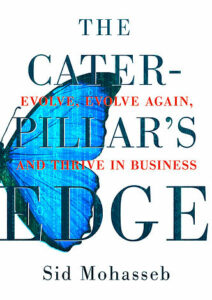Master Near Constant Change
Many people think that businesses should develop a strategy and stick to it at all costs.
But Sid Mohasseb, serial entrepreneur, investor, venture capitalist, and former the Head of Strategic Innovation for KPMG’s Strategy Practice teaches an entirely different approach: It’s the ability to adjust your strategy, almost constantly, that brings success. The environment is uncertain and changing, and changing with it is vital.
Sid teaches that we must push for more and evolve from one approach to another.
I recently had the opportunity to talk with him about his new book, The Caterpillar’s Edge: Evolve, Evolve Again, and Thrive in Business.
Prepare for Constant Flux
Why a caterpillar?
The caterpillar evolves many times over before it becomes a butterfly. It changes form until it turns into a completely different species. The caterpillar teaches us the wisdom of constant and incremental evolution and offers the promise of flying. To compete, to advance and to win, in our businesses and in our personal lives, we must evolve constantly and purposefully, always.
How is the game changing? And how do leaders prepare for the constant flux?
Innovation is constantly approaching from every corner of the world. The speed of change fueled by unprecedented technological advancements and constantly increasing customer expectations are challenging companies to “stay relevant” – competitive advantages are temporary. The game has changed from, “How do I gain an advantage and defend it?” to “How do I change to stay relevant?”
To win in a state of constant flux, leaders must shift their minds and change their actions. First, by realizing their addictions (old assumptions, orthodoxies, biases, etc.). Next, by aligning with uncertainty – no plans can be permanent and no decisions are certain. Leaders must learn to live with probability and a portfolio of related plans – always ready to take the path that offers the most likelihood of success. They should also appreciate the reality of their capabilities and aim to build the future in increments; success cycles must be shorter and capabilities (people & systems) have to be created accordingly. Last, leaders must constantly look for the next advantage and aspire for more “Aha’s.” They should look for and discover the next challenge or opportunity, always; innovate, always (create new value), and evolve, always.
How to Embrace Change
Why do we so often refuse to deal with change and uncertainty?
The refusal is more natural than intentional. We refuse to deal with change because of our fears of unknown (what is on the other side of change) and comfort with the status quo (comfortable routines we are used to and have served us well in the past). Most people embrace change when they i) realize the severity of the problem they face and ii) gain trust that what they can change to is a better state. We often refuse to change because we believe that the status quo does not present a major danger and/or we don’t trust the alternative paths offered by our leaders.
At business school and later at work, we are trained to look for certainty to plan to and execute against – assuming reduced risk. In our personal lives, we are comfortable living with probability and operating in uncertainly – there is a 40% chance of rain, and we decide, based on our risk tolerance, to take an umbrella or not. In our professional lives, we are expected to be certain and execute with confidence in outcomes. People, on a personal level, can innately adjust to uncertainty. However, they are reluctant operating with uncertainty at work because corporations expect and reward the illusion of certainty.
3 Categories for Leaders to Plan in a World of Change
What’s the best way for a leadership team to plan and strategize in a world of constant change?
I offer three categories of activities in Chapter 7 of the book. But emphasize a disclaimer: competing and winning in the world ahead is not about managing with canned processes or charts; it is about realizing the uniqueness of each organization and defining its unique path of emergence.
First category of actions are addiction busters – For example:
- Strategic recommendations should be made based on defensible probabilistic scenarios (quantify your decisions and the path you take for making those decisions)—no more conservative, optimistic and likely options.
- Every plan has to offer a wave of strategies—a collection of related strategies with identifiable pivot points; demand to see the signals that will be monitored to trigger a pivot.
- Demand that all analysis must always offer multiple views of the problem or the opportunity—force the organization to always look at issues from various angles (by changing their frame of reference) and backing up their insights with data.
Second category of actions are Insight Busters – For example:
- Always remember, it is about the problem not the solution— about the questions not the answers. Don’t start with finding what you want— having a specific end in mind assumes the knowledge of the future; end goals will shift.
- Control your urges to solve first and justify with data later. To gain new insight, always look to disprove yourself. Allow your conventional assumptions to be challenged.
- Avoid getting a filtered view of the world— too much automated analytics results in ignoring new issues and rehashing the opportunities and problems framed up in the past.
The third and last category of actions are Momentum Builders – For example:
- Don’t aim to empower people. Aim to unleash the inherent abilities people bring to the organization—the power of imagination, action, and innovation. Let people belong and help drive your emergence.
- Declare that failure is no longer toxic—make it safe to experiment. Most experts preach fail fast, fail often; I think we should learn fast and learn often – failure is just a path and not the end goal.
- Erase the line between planning and execution. Be upfront with the organization: you will change the plan when needed; the month of the year is not going to dictate your destiny and the ability to gain a timely advantage.
Avoid these Common Errors
From your observations, what are a few of the most common, repeatable management errors made today?
It is often the compounding effect of actions that results in regrets. What I mean is that it is not easy to point to single universal errors and mistakes – don’t we all wish it was that simple! There are generally a series of activities and choices, all made in good faith, that collectively lead to poor decisions or in most cases lack of timely decisions to evolve. Here are a few areas of vulnerability:
- The budgeting process drives innovation and change: The allocation process, organizational power centers and conformity of ideas to the past trends influenced by the fiscal calendar. As we wait and massage ideas to fit submission forms and follow past trends, we miss opportunities.
- This is the way it has always been done in our industry or company: This is when company-changing ideas (big advantages) are dead on arrival – we kill the caterpillars before they ever have the chance of becoming a butterfly!
- Confusing innovation with incremental improvement: imposing conventional processes appropriate for R&D efforts over the messy innovation activities – stage gating innovation initiatives by arbitrary timelines.
Curiosity. How do you encourage it? What stifles it?
We should distinguish between purposeful curiosity and curiosity for the sake of curiosity. Purposeful curiosity is supported by data and discovery of new value propositions – its direction and velocity of convergence can be observed. To encourage purposeful curiosity, it should be measured and rewarded (like anything else, only what gets measured gets done). It should be embedded into the culture of the organization. It should be considered a key pillar of the company’s ability to find the next advantage. On the flip side, curiosity for the sake of curiosity should be restrained as it wastes resources and delays progress as the organization is dazzled with shiny new objects—a distinction that many companies fail to make, as they confuse efforts with results.
What ways have you seen competitive advantage built and sustained over the long haul?
Let’s change the definition of sustainability and get over the notion of “long haul.” Today, all advantages are temporary. Winning over and over is a function of building the future, always, and not defending the past with vigor.
Sustainability should be viewed as the ability of an organization to constantly discover and shape itself to effectively execute and realize new advantages – over and over and in a timely manner. In other words, we should no longer try to build sustainable competitive advantages but rather create “competitively sustainable organizations.”
As for the “long haul,” in a world where all is in flux and innovation in products, experiences and business models are born every minute, aiming for “long haul” sustainability is a fool’s choice. A choice that makes us feel secure but leaves us vulnerable against the reality of change.
As a former head of strategic innovation, how do you define innovation? Is innovation a teachable skill?
 I believe innovation is more of an attitude than a skill. And, yes, I think you can stimulate the attitude to innovate by providing the right organizational culture—by leaders believing and allowing the organization to believe that we as an organization deserve more and collectively have the ability to create more – more value, more innovation, and more relevancy to our customers.
I believe innovation is more of an attitude than a skill. And, yes, I think you can stimulate the attitude to innovate by providing the right organizational culture—by leaders believing and allowing the organization to believe that we as an organization deserve more and collectively have the ability to create more – more value, more innovation, and more relevancy to our customers.
I define innovation as creating “new” value as opposed to tinkering with the old to improve functionality. New value is often hidden in the unknown and not necessarily served on a platter or found within known facts. Innovation requires both thinking and doing and is different from ideation. The innovation process begins with discovery, requires imagination and purposefulness, and can only be validated and crystallized through incremental experimentation and learning exercises.
For more information, see The Caterpillar’s Edge: Evolve, Evolve Again, and Thrive in Business

